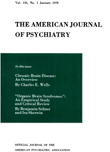SQUARE WAVES (BST) VERSUS SINE WAVES IN ELECTROCONVULSIVE THERAPY
Abstract
1. A report on our first year's experience with the Liberson-Offner Brief Stimulus technique for electroconvulsive therapy is presented in comparison with conventional sine wave technique.
2. Clinical study shows these methods to be equally effective in so far as observable improvement is concerned.
3. Electroencephalographic studies indicate the brief stimulus therapy method produces a significant reduction in post treatment electrocortical disturbance. The evidence at present does not permit a statement of the presence or absence of irreversible brain changes.
4. It is postulated that the electrocortical disturbance is of no favorable or adverse significance in the clinical course. The amount of confusion produced seems similarly to be of little or no clinical significance.
5. We have observed a greater incidence of fractures of the spine following treatment with brief stimulus therapy and conclude from this and from direct observation that the physical violence of the seizures is no different with either method.
6. As an incidental observation, it seems that electroconvulsive therapy is of value in the treatment of schizophrenics and that this value does not depend upon the presence of depression in the schizophrenic symptomatology.
7. Finally, we do not find any overwhelming evidence to indicate preference for either type of stimulator in clinical practice, although certain aspects of either method may be more or less objectionable in relation to the immediate feelings of given patients.
Access content
To read the fulltext, please use one of the options below to sign in or purchase access.- Personal login
- Institutional Login
- Sign in via OpenAthens
- Register for access
-
Please login/register if you wish to pair your device and check access availability.
Not a subscriber?
PsychiatryOnline subscription options offer access to the DSM-5 library, books, journals, CME, and patient resources. This all-in-one virtual library provides psychiatrists and mental health professionals with key resources for diagnosis, treatment, research, and professional development.
Need more help? PsychiatryOnline Customer Service may be reached by emailing [email protected] or by calling 800-368-5777 (in the U.S.) or 703-907-7322 (outside the U.S.).



